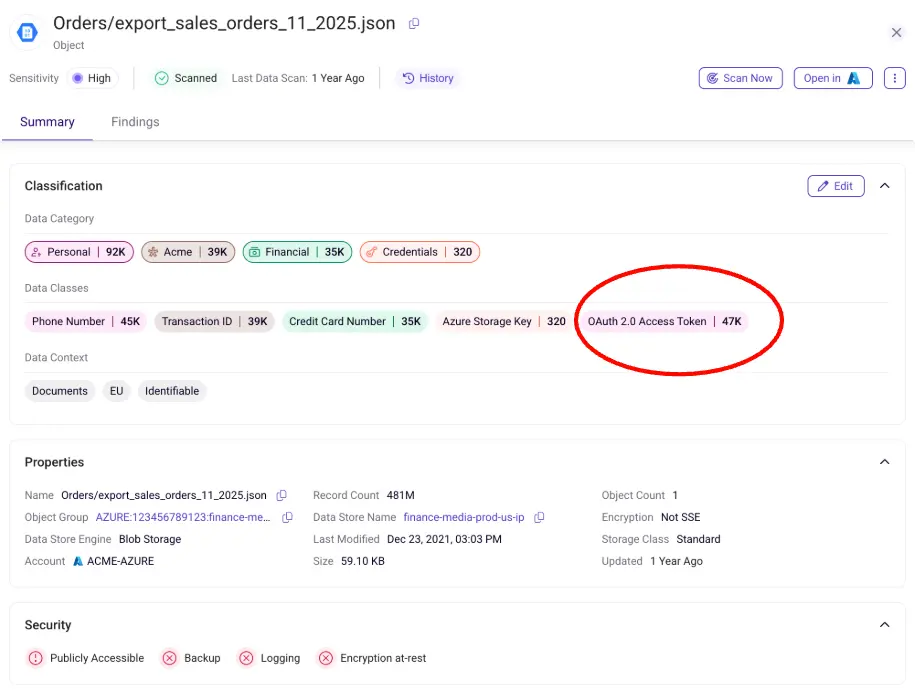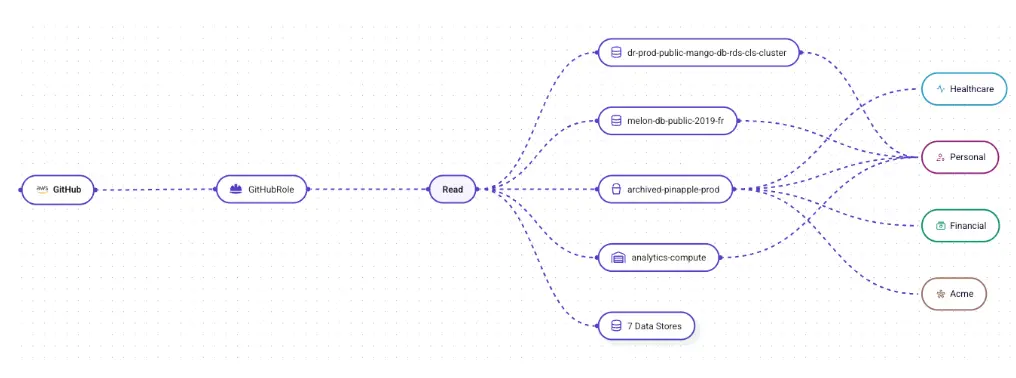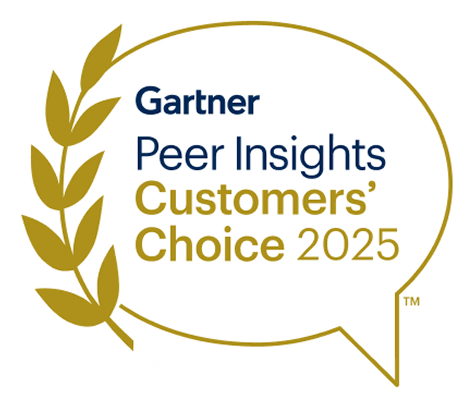Securing the Cloud: Advanced Strategies for Continuous Data Monitoring
In today's digital world, data security in the cloud is essential. You rely on popular observability tools to track availability, performance, and usage—tools that keep your systems running smoothly. However, as your data flows continuously between systems and regions, you need a layer of security that delivers granular insights without disrupting performance.
Cloud service platforms provide the agility and efficiency you expect; however, they often lack the ability to monitor real-time data movement, access, and risk across diverse environments.
This blog post explains how cloud data monitoring strategies protect your data while addressing issues like data sprawl, data proliferation, and unstructured data challenges. Along the way, we will share practical information to help you deepen your understanding and strengthen your overall security posture.
Why Real-Time Cloud Monitoring Matters
In the cloud, data does not remain static. It shifts between environments, services, and geographical locations. As you manage these flows, a critical question arises: "Where is my sensitive cloud data stored?"
Knowing the exact location of your data in real-time is crucial for mitigating unauthorized access, preventing compliance issues, and effectively addressing data sprawl and proliferation.
Risk of Data Misplacement: When Data Is Stored Outside Approved Environments
Misplaced data refers to information stored outside its approved environment. This can occur when data is in unauthorized or unverified cloud instances or shadow IT systems. Such misplacement heightens security risks and complicates compliance efforts.
A simple table can clarify the differences in risk levels and possible mitigation strategies for various data storage environments:
Risk of Insufficient Monitoring: Gaps in Real-Time Visibility of Rapid Data Movements
The high velocity of data flows in vast cloud environments makes tracking data challenging, and traditional monitoring methods may fall short.
The rapid data movement means that data proliferation often outstrips traditional monitoring efforts. Meanwhile, the sheer volume, variety, and velocity of data require risk analysis tools that are built for scale.
Legacy systems typically struggle with these issues, making it difficult for you to maintain up-to-date oversight and achieve a comprehensive security posture. Explore Sentra's blog on data movement risks for additional details.
Limitations of Legacy Data Security Solutions
When evaluating how to manage and monitor cloud data, it’s clear that traditional security tools fall short in today’s complex, cloud-native environments.
Older security solutions (built for the on-prem era!) were designed for static environments, while today's dynamic cloud demands modern, more scalable approaches. Legacy data classification methods, as discussed in this Sentra analysis, also fail to manage unstructured data effectively.
Let’s take a deeper look at their limitations:
- Inadequate data classification: Traditional data classification often relies on manual processes that fail to keep pace with real-time cloud operations. Manual classification is inefficient and prone to error, making it challenging to quickly identify and secure sensitive information.
- Such outdated methods particularly struggle with unstructured data management, leaving gaps in visibility.
- Scalability issues: As your enterprise grows and embraces the cloud, the volume of data you must handle also grows exponentially. When this happens, legacy systems cannot keep up. They lag behind and are slow to respond to potential risks, exposing your company to possible security breaches.
- Modern requirements for cloud data management and monitoring call for solutions that scale with your business.
- High operational costs: Maintaining outdated security tools can be expensive. Legacy systems often incur high operational costs due to manual oversight, taxing cloud compute consumption, and inefficient processes.
- These costs can escalate quickly, especially compared to cloud-native solutions offering automation, efficiency, and streamlined management.
To address these risks, it's essential to have a strategy that shows you how to monitor data as it moves, ensuring that sensitive files never end up in unapproved environments.
Best Practices for Cloud Data Monitoring and Protection
In an era of rapidly evolving cloud environments, implementing a cohesive cloud data monitoring strategy that integrates actionable recommendations is essential. This approach combines automated data discovery, real-time monitoring, robust access governance, and continuous compliance validation to secure sensitive cloud data and address emerging threats effectively.
Automated Data Discovery and Classification
Implementing an agentless, cloud-native solution enables you to continuously discover and classify sensitive data without any performance drawbacks. Automation significantly reduces manual errors and delivers real-time insights for robust and efficient data monitoring.
Benefits include:
- Continuous data discovery and classification
- Fewer manual interventions
- Real-time risk assessment
- Lower operational costs through automation
- Simplified deployment and ongoing maintenance
- Rapid response to emerging risks with minimal disruption
By adopting a cloud-native data security platform, you gain deeper visibility into your sensitive data without adding system overhead.
Real-Time Data Movement Monitoring
To prevent breaches, real-time cloud monitoring is critical. Receiving real-time alerts will empower you to take action quickly and mitigate threats in the event of unauthorized transfers or suspicious activities.
A well-designed monitoring dashboard can visually display data flows, alert statuses, and remediation actions—all of which provide clear, actionable insights. Alerts can also flow directly to remediation platforms such as ITSM or SOAR systems.
In addition to real-time dashboards, implement automated alerting workflows that integrate with your existing incident response tools. This ensures immediate visibility when anomalies occur for a swift and coordinated response. Continuous monitoring highlights any unusual data movement, helping security teams stay ahead of threats in an environment where data volumes and velocities are constantly expanding.
Robust Access Governance
Only authorized parties should be able to access and utilize sensitive data. Maintain strict oversight by enforcing least privilege access and performing regular reviews. This not only safeguards data but also helps you adhere to the compliance requirements of any relevant regulatory standards.
A checklist for robust governance might include:
- Implementation of role-based and attribute-based access control
- Periodic access audits
- Integration with identity management systems
Ensuring Compliance and Data Privacy
Adhering to data privacy regulations that apply to your sector or location is a must. Continuous monitoring and proactive validation will help you identify and address compliance gaps before your organization is hit with a security breach or legal violation. Sentra offers actionable steps related to various regulations to solidify your compliance posture.
Integrating automated compliance checks into your security processes helps you meet regulatory requirements. To learn more about scaling your security infrastructure, refer to Sentra’s guide to achieving exabyte-scale enterprise data security.
Beyond tools and processes, cultivating a security-minded culture is critical. Conduct regular training sessions and simulated breach exercises so that everyone understands how to handle sensitive data responsibly. Encouraging active participation and accountability across the organization solidifies your security posture, bridging the gap between technical controls and human vigilance.
Sentra Addresses Cloud Data Monitoring Challenges
Sentra's platform complements your current observability tools, enhancing them with robust data security capabilities. Let’s explore how Sentra addresses common challenges in cloud data monitoring.
Exabyte-Scale Mastery: Navigating Expansive Data Ecosystems
Sentra’s platform is designed to handle enormous data volumes with ease. Its distributed architecture and elastic scaling provide comprehensive oversight and ensure high performance as data proliferation intensifies. The platform's distributed architecture and elastic scaling capabilities guarantee high performance, regardless of data volume.
Key features:
- Distributed architecture for high-volume data
- Elastic scaling for dynamic cloud environments
- Integration with primary cloud services
Seamless Automation: Transforming Manual Workflows into Continuous Security
By automating data discovery, classification, and monitoring, Sentra eliminates the need for extensive manual intervention. This streamlined approach provides uninterrupted protection and rapid threat response.
Automation is essential for addressing the challenges of data sprawl without compromising system performance.
Deep Insights & Intelligent Validation: Harnessing Context for Proactive Risk Detection
Sentra distinguishes itself by providing deep contextual analysis of your data. Its intelligent validation process efficiently detects anomalies and prioritizes risks, enabling precise and proactive remediation.
This capability directly addresses the primary concern of achieving continuous, real-time monitoring and ensuring precise, efficient data protection.
Unified Security: Integrating with your Existing Systems for Enhanced Protection
One of the most significant advantages of Sentra's platform is its seamless integration with your current SIEM and SOAR tools. This unified approach allows you to maintain excellent observability with your trusted systems while benefiting from enhanced security measures without any operational disruption.
Conclusion
Effective cloud data monitoring is achieved by blending the strengths of your trusted observability tools with advanced security measures. By automating data discovery and classification, establishing real-time monitoring, and enforcing robust access governance, you can safeguard your data against emerging threats.
Elevate your operations with an extra layer of automated, cloud-native security that tackles data sprawl, proliferation, and compliance challenges. After carefully reviewing your current security and identifying any gaps, invest in modern tools that provide visibility, protection, and resilience.
Maintaining cloud security is a continuous task that demands vigilance, innovation, and proactive decision-making. Integrating solutions like Sentra's platform into your security framework will offer robust, scalable protection that evolves with your business needs. The future of your data security is in your hands, so take decisive steps to build a safer, more secure cloud environment.
<blogcta-big>











.webp)
.webp)



